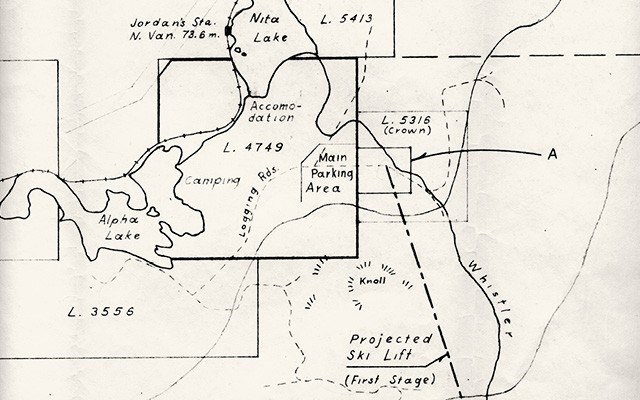The power lines that run through the Whistler valley, carrying electricity from Seton to Cheekye, are what drew Peter Alder to the Sea to Sky corridor 60 years ago. But it was the area's skiing potential that sparked his imagination.
Many people know Peter as the man who has managed some of British Columbia's major ski areas, including Whistler Mountain; who led Tourism Whistler through the recession of the early '80s; who has been a consultant to resorts around the world, primarily working with Whistler's Ecosign Mountain Resort Planners. But these job titles suggest only one facet of Peter's life. The Swiss-born engineer has never conformed exactly to type; diverging from one career path to another, always analyzing situations, searching for other ways of doing things and, even now in his 85th year, looking ahead with excitement and optimism.
But it was one of Peter's earliest ventures that could have led him, and Whistler, in a very different direction.
Peter came to Squamish in 1955 to assist in the construction of B.C. Electric's Seton-Cheekye transmission line. At that time Squamish was still a remote village; a ferry provided the only reliable access to Vancouver. The "graceful" power lines were Peter's job — "Look how they hang so rhythmically and go around the corners so nicely," he says, only half in jest — but his real interest, born of his parents and his Swiss heritage, was skiing.
A few years before moving to Squamish he had done a multi-day traverse from Indian Arm through to the Spearhead Range. Once based in Squamish, he spent much of his free time, and some of his work time, surveying mountains that might be suitable for development as a ski area.
"I climbed every bloody ridge and hill, particularly around Alta Lake and down by Garibaldi and Mount Cloudburst," he recalls.
On weekends Peter drove a bus for Ottar and Emil Brandvold, two Norwegian brothers who had built a ski chalet at Diamond Head. He was also involved in founding a ski club in Squamish and with putting a rope tow on St. Paul's Ridge in Garibaldi Park.
As he grew to understand the area he became more convinced of its potential for ski development. By the time the transmission line was finished in 1956 Peter had decided to stay in Squamish with the long-term goal of developing a ski area.
But first he needed an income to sustain his family.
Instead of looking for a job Peter looked for an opportunity. He founded Peter Alder Company, or "Paco," which is where Squamish's Paco Road got its name. The company's subsidiaries, Paco Building Supplies and Paco Cement, both flourished, with the PGE Railroad being an important customer of the cement company. The new highway connecting Squamish to Vancouver — completed in 1959 — helped keep the building supply company busy.
The lineage of both of Peter's companies can still be traced today. Paco Cement is now Cardinal Concrete while Paco Building Supplies became Garibaldi Building Supplies and later Mountain Building Centres. In 2006 Rona acquired Mountain Building Centres.
Things were going well for Peter and Paco in Squamish — until the landscape suddenly changed in 1960. Inspired by the Squaw Valley Olympics and encouraged by the Canadian Olympic Association's Sidney Dawes, a group of Vancouver businessmen hatched the idea of building a ski area at Alta Lake to host the 1968 Winter Olympics. With support from Premier WAC Bennett and favourable coverage in the Vancouver media the new Garibaldi Olympic Development Association (GODA) had, in a matter of a few weeks, usurped an idea Peter had been working on for five years.
But in the eyes of a European immigrant British Columbia appeared full of opportunities. Familiar with what is now the Whistler valley from his days with B.C. Electric, Peter knew the Jordan family and discovered that their Jordan's Lodge property — 160 acres between Alpha and Nita Lakes and extending almost to the base of Whistler Mountain — was available. Peter and eight other investors each put $2,000 down and bought the property.
Originally Peter's group, Garibaldi Recreations Ltd., had its own plans for developing lifts on Whistler Mountain, with Peter's father working to obtain Swiss financing. Later, they decided to present a development proposal to Garibaldi Lifts Ltd., the company set up by members of GODA to develop Whistler Mountain.
It seemed like a straight-forward business deal — except that Garibaldi Lifts was under the impression they had secured the Jordan's Lodge property. In fact, when the Canadian Olympic Association chose Banff as Canada's bid for the 1968 Winter Olympics the Garibaldi Olympic Development Association inadvertantly let their option on the Jordan's Lodge property expire.
So when Peter walked into the offices of Garibaldi Lifts to present his group's proposal to Franz Wilhelmsen there was a moment of stunned silence while Franz began to comprehend what had happened.
Then the air turned blue with expletives — followed shortly by Peter's unceremonious exit.
"He threw me out of his office, pretty near physically," Peter says. "He told me to go and fly a kite. He was so mad that we had bought the land which they were sure they had owned."
Next week Alder tells the story of how he eventually became vice president of Garibaldi Lifts Ltd.
Bob Barnett, Pique's founding publisher and editor, is re-joining the editorial pages to help celebrate Whistler's 40th anniversary on Sept.6. through weekly columns about the resort's past




